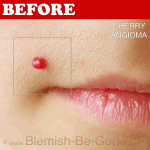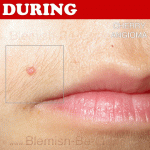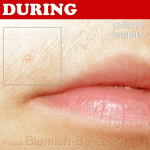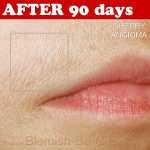Characteristics of Cherry Angiomas
Cherry angiomas are made up of clusters of capillaries at the surface of the skin, forming a tiny round dome (” papule”), which might be flat topped. They vary in color from bright red to purple. When they initially develop, they might be only a tenth of a millimeter in diameter and practically flat, appearing as little red dots. However, they then normally grow to about one or two millimeters around, and in some cases to a centimeter or more in diameter. As they grow larger, they are inclined to broaden in thickness, and could take on the raised and rounded shape of a dome. Various adjoining angiomas are said to form a polypoid angioma. Because the blood vessels making up an angioma are so close to the skin’s surface, cherry angiomas may bleed profusely if they are hurt.
One research located that the majority of capillaries in cherry hemangiomas are fenestrated because of staining for carbonic anhydrase activity.
CLICK HERE for information on the natural removal of cherry angiomas you can do at home!
What Causes Cherry Angiomas
Cherry angiomas appear spontaneously in many people in middle age however are able to even, although less common, arise in young people. They are able to also arise in a bold eruptive manner in any sort of age. The underlying cause for the advancement of cherry angiomas is not understood, a great deal because of a lack of interest in the subject. This is probably because they hardly ever are caused by an internal malignancy.
The first research trying to bring light to the molecular and genetic mechanisms behind cherry/senile hemangioma was recently published. 4 The research discovered that the level of MicroRNA 424 is substantially slashed in senile hemangiomas compared to normal skin causing increased protein expression of MEK1 and Cyclin E1. By hindering mir-424 in normal endothelial cells they might watch the same increased protein expression of MEK1 and Cyclin E1 which, important for the advancement of senile hemangioma; generated cell proliferation of the endothelial cells. They additionally located that targeting MEK1 and Cyclin E1 by having tiny obstructing RNA decreased the number of endothelial cells.
Chemicals and compounds that have been seen to induce cherry angiomas are mustard gas, 2-butoxyethanol, bromides and cyclosporine. A significant boost in the density of mast cells has been watched in cherry hemangiomas compared with typical skin.
Cherry angiomas, additionally known as Campbell De Morgan spots or Senile angiomas, are cherry red papules on the skin containing an uncommon proliferation of blood vessels. They are the most common kind of angioma. They are called Campbell de Morgan spots after the nineteenth-century British physician Campbell De Morgan, that first noted and detailed them. The frequency of cherry angiomas increases by having age.
CLICK HERE to know more about a quick, easy, cheap, and natural Cherry Angiomas removal treatment you can do at home!
Cherry Angiomas Treatment
On the uncommon occasions that they call for removal, traditionally cryosurgery or electrosurgery have been utilized. More just recently pulsed dye laser or Intense Pulsed Light (IPL) therapy has additionally been utilized.
Future therapy based on an in your area acting inhibitor of MEK1 and Cyclin E1 might potentially be a selection. A natural MEK1 inhibitor is Myricetin.
However, there is a very cheap and effective natural treatment you can perform at home that will get rid of your cherry angiomas. It’s called the Miracle Cure Duo remedy, and comprises of a natural blemish remover (blemish drops), and a skin protector. Between 3 weeks and 90 days, your cherry angiomas should be gone. Click here to learn more.
Here’s some photos of what it can do….
 |
 |
 |
 |
Amazing natural cure for cherry angiomas, Click here .
Prognosis
In most patients, the number and size of cherry angiomas increases with advancing age. They are gentle, except in very uncommon situations that involve a sudden appearance of many angiomas, which can be a sign of an establishing inner malignancy.
Epidemiology
Cherry angiomas transpire in all races, ethnic backgrounds, and both sexes.
CLICK HERE for an effective natural cherry angiomas treatment!
Cherry Angiomas Sources, Incidence, and Risk Aspects
Cherry angiomas are rather common skin growths that differ in size. They are able to take place virtually anywhere on the body, however typically develop on the trunk.
They are most typical after age 30. The cause is unknown, but they tend to be inherited (genetic).
Manifestations
Skin lesion or development:
- Bright cherry-red
- Tiny– pinhead size to about 1/4 inch in diameter
- Smooth, or can stick out from the skin
Signs and tests
Your health care carrier will undoubtedly identify a cherry angioma based on the look of the development. No further evaluations are usually necessary, though a skin biopsy may be used to affirm the medical diagnosis.
More Cherry Angiomas Treatment
Cherry angiomas typically do not have to be treated. Removing unwanted facial irritants can be as easy as finding the right cream or lotion. However some issues require more complex solutions, like a professional microdermabrasion machine for example. Make sure you educate yourself on what your specific situation calls for.
If they are cosmetically unattractive or they bleed typically, angiomas could be gotten rid of by:
- Burning (electrosurgery/cautery)
- Freezing (cryotherapy)
- Laser
- Shave excision
- Miracle Cure Duo remedy
To learn a natural treatment for Cherry Angiomas you can do at home, CLICK HERE!
Expectations (diagnosis)
Cherry angiomas are noncancerous and generally innocent. Removal normally does not induce scarring.
Complications
- Bleeding if they are hurt
- Changes in look
- Mental distress
Calling your health care company
Call for a visit by having your health care carrier if:
- You have indicators of a cherry angioma and you would want to need it got rid of
- The appearance of a cherry angioma or any skin lesion changes
Removing cherry angiomas at home is easy, quick, and painless, CLICK HERE to find out how!
Related Keywords: cherry angiomas, cherry angiomas cause, cherry angiomas removal, cherry angiomas treatment, how to remove cherry angiomas, red moles cherry angiomas, removal of cherry angiomas, remove cherry angiomas, removing cherry angiomas, removing cherry angiomas at home, treatment for cherry angiomas, what causes cherry angiomas
